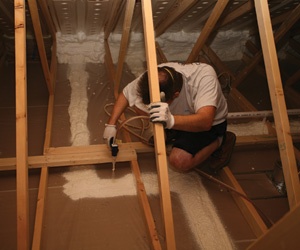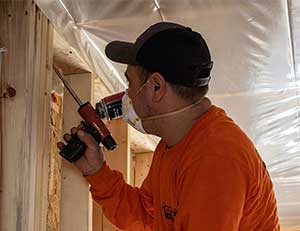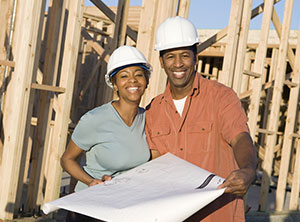The excitement of building a new home often focuses on choosing countertops and paint colors, but there’s something equally important you can’t see: your indoor air quality (IAQ). With Americans spending approximately 90% of their time indoors, the quality of our indoor environment has never been more crucial for our health and well-being. Let’s explore why IAQ matters and how to create a healthy indoor environment in the home you’re building from day one.
Why Indoor Air Quality Matters in New Construction
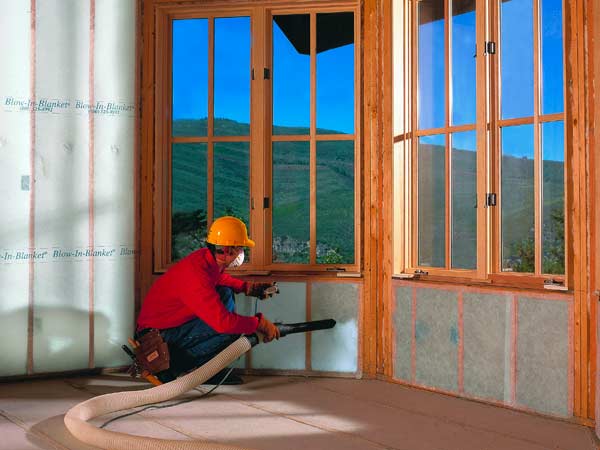
That “new home smell” many people love? Unfortunately, it’s often a sign of volatile organic compounds (VOCs) being released from building materials and finishes. These chemicals can have both short term and long-term health impacts that might not be immediately apparent.
Many manufacturers are working to eliminate harmful chemicals from their products. For example, fiberglass insulation was often made with asbestos or formaldehyde in years past but is now manufactured without either harmful chemical. Other insulations, such as cellulose insulation, are made from eco-friendly products like recycled paper and treated with boric acid, a common chemical found in many eye drops.
Sources of Indoor Air Pollutants in New Homes
Understanding where pollutants indoors come from is crucial for prevention. Building materials like paints, adhesives, and composite wood products can release harmful chemicals into your indoor environment. Improperly installed HVAC systems may also circulate both indoor and outdoor air pollutants throughout your home project.
Another significant concern is carbon monoxide from combustion appliances, which requires proper ventilation to maintain safe indoor and outdoor air exchange. Additionally, Maryland homes face potential exposure to radon gas, a naturally occurring radioactive gas that can affect outdoor air quality and seep into homes through foundation cracks.
Strategies for Building a Healthy Home
Material Selection
Start with choosing low-VOC paints, adhesives, and flooring materials. When selecting insulation, consider options like cellulose insulation, which offers excellent performance without harmful chemical binders. Natural materials generally contribute to better indoor air quality.
Proper Ventilation
Improving ventilation is also essential for maintaining healthy indoor air. Install an effective ventilation system that includes heat recovery ventilators (HRVs) to efficiently exchange stale indoor air with fresh outdoor air. Pay special attention to moisture-prone areas like bathrooms and kitchens to prevent mold growth.
Air Sealing and Insulation
Create a tight building envelope through proper air sealing, preventing unwanted air infiltration while controlling moisture. Quality insulation plays a crucial role in this process, with options like spray foam providing excellent air-sealing properties.
HVAC System Design and Installation
Work with qualified contractors to design and install an HVAC system that provides adequate filtration and ventilation. Consider using high-efficiency filters to remove smaller particles.
Moisture Control
Implement proper drainage and vapor barriers during construction to prevent future moisture problems that could lead to mold growth.
Radon Mitigation
If radon is a concern in your area, it’s important to incorporate radon-resistant construction techniques and consider installing a radon mitigation system to ensure you build a radon-resistant home.
Beyond Construction: Maintaining Healthy Indoor Air
Post-construction cleanup is crucial for removing construction dust and debris. Encourage future homeowners to establish a regular maintenance schedule for their HVAC system, including filter replacements, to ensure clean and efficient airflow. Practice source control by using low-VOC cleaning products and maintaining appropriate humidity levels to discourage mold and dust mites.
Harvard University’s Chan School of Public Health, frequently discusses how the quality of our indoor environment significantly impacts our daily health and well-being. They offer up some valuable tips on how to create a healthier home now and for the future.
Your Partner in Creating Healthy Homes
Building a new home presents a unique opportunity to create a healthy living environment from the ground up. By prioritizing indoor air quality during construction, you give future homeowners the ability to maintain it afterward and invest in their family’s health and comfort for years to come.
Consult with a qualified builder or IAQ specialist who understands the importance of improving indoor air quality. For more information about matters and how to improve your home building project’s air quality, visit the EPA’s Indoor Air Quality website. A future family’s health is worth the investment in proper planning and implementation of these crucial IAQ strategies.
At DeVere Insulation, we’re committed to creating safe, energy efficient homes for Baltimore families with the highest quality products and services. Contact us today to learn more about how insulation can improve your new home project’s indoor air quality and help create a healthy home environment.

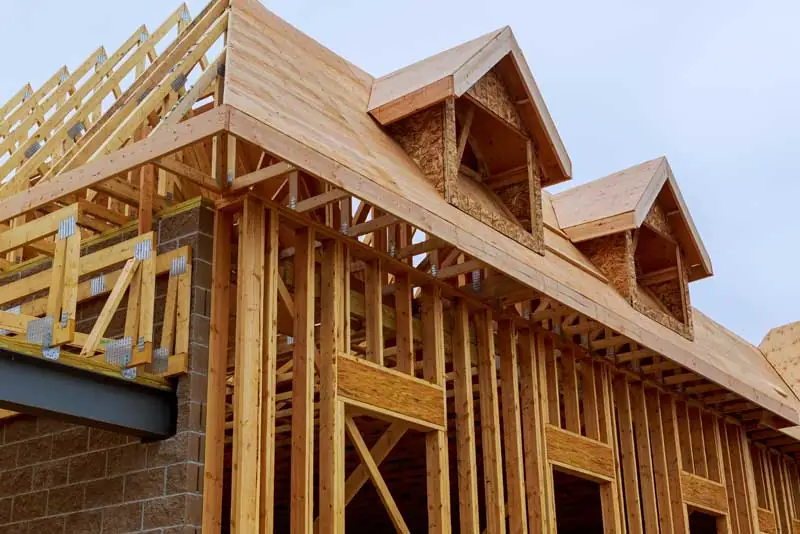
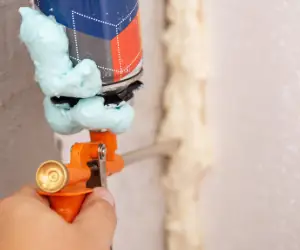
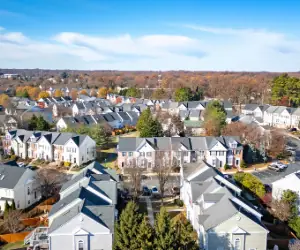
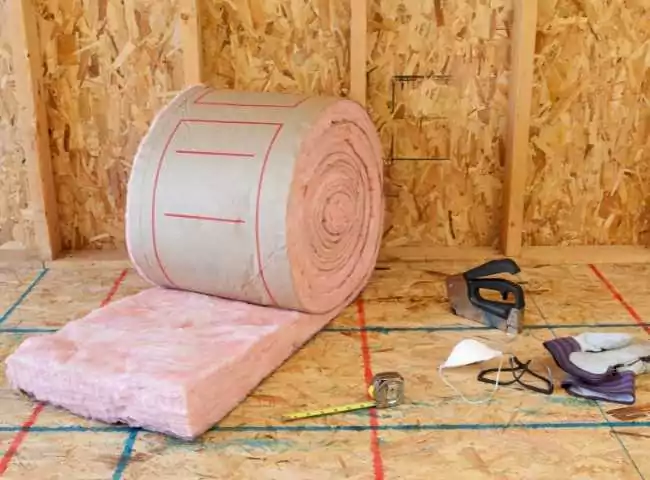
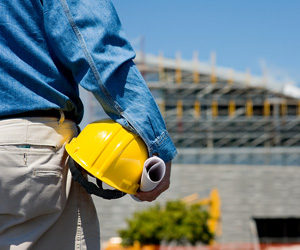 Maryland offers its residents a delightful mix of urban sophistication and natural beauty, but within this charm lies a challenge that every Maryland resident knows too well–the unpredictable weather. From scorching summers to chilly winters, the temperature swings can be discomforting, not to mention the toll they take on your wallet through high energy bills. But don’t worry, when undergoing new construction there’s a solution that will maximize your new home or business project’s energy efficiency and keep future owners’ energy expenses under control: proper insulation.
Maryland offers its residents a delightful mix of urban sophistication and natural beauty, but within this charm lies a challenge that every Maryland resident knows too well–the unpredictable weather. From scorching summers to chilly winters, the temperature swings can be discomforting, not to mention the toll they take on your wallet through high energy bills. But don’t worry, when undergoing new construction there’s a solution that will maximize your new home or business project’s energy efficiency and keep future owners’ energy expenses under control: proper insulation. When it comes to properly insulating your new construction project, it’s always wisest to trust the job to the expertise of a professional. A reputable, licensed insulation contractor in Maryland, such as DeVere Insulation, can assess your building project’s specific needs and recommend the most effective insulation solutions, ensuring that your investment in new home insulation pays off for years to come.
When it comes to properly insulating your new construction project, it’s always wisest to trust the job to the expertise of a professional. A reputable, licensed insulation contractor in Maryland, such as DeVere Insulation, can assess your building project’s specific needs and recommend the most effective insulation solutions, ensuring that your investment in new home insulation pays off for years to come. Are you ready to ensure future owners are moving into a comfortable, energy-efficient home or business? Maryland’s weather may be unpredictable, but with the right insulation solutions in place, you can take control over your new home or business building project’s comfort and energy efficiency.
Are you ready to ensure future owners are moving into a comfortable, energy-efficient home or business? Maryland’s weather may be unpredictable, but with the right insulation solutions in place, you can take control over your new home or business building project’s comfort and energy efficiency.




